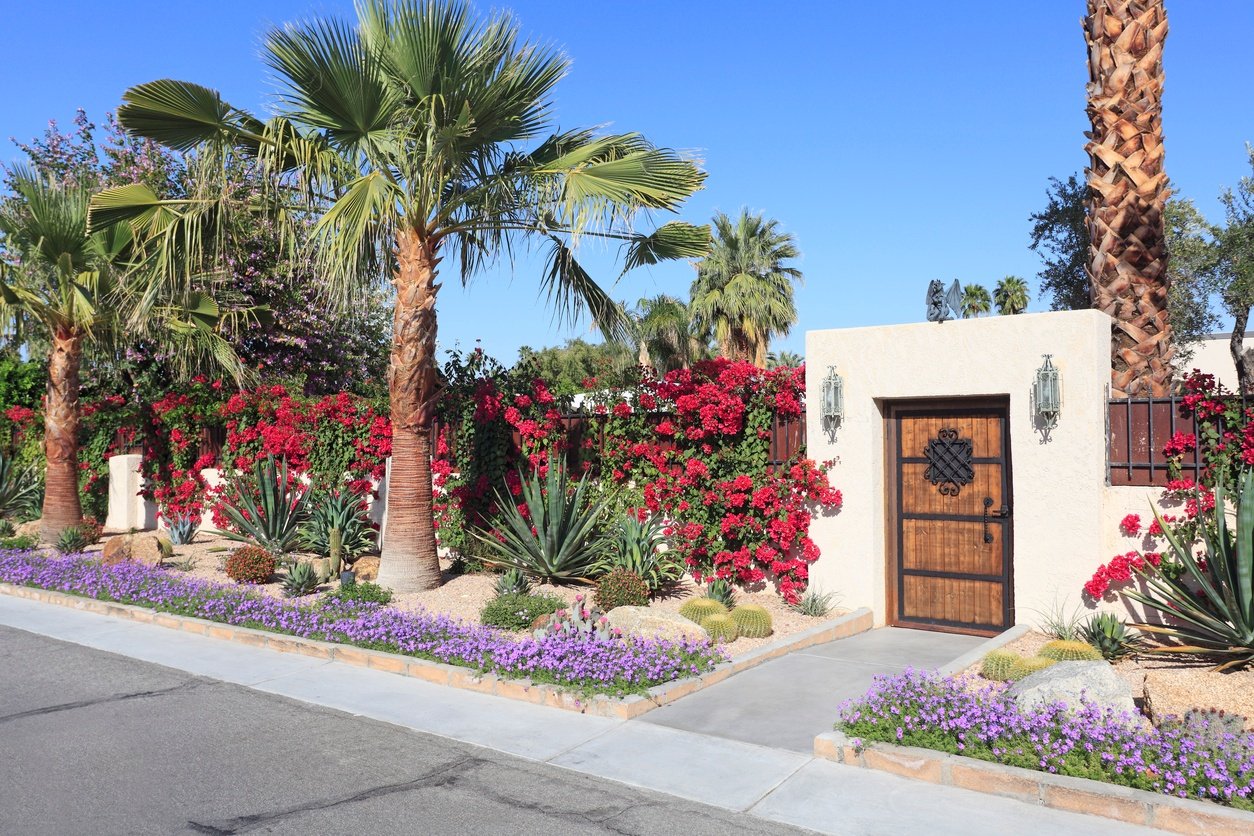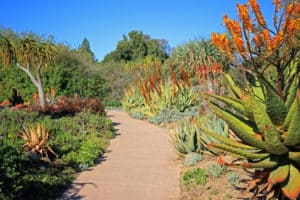Drought is a regular occurrence in many climates, and will probably remain a challenge for centuries to come. Watering any landscape costs money and drains the water table. Businesses and homeowners would be wise to find ways to limit the amount of water that they use, and the easiest way to do that is to plan the landscape with water conservation in mind.
How do you do that? The best way is to plan according to the climate you live in. Fortunately, with growing trends in xeriscaping, and drought-tolerant plants, there are many beautiful ways to add to the look of your outdoor space while still conserving.
Here are a few suggestions for three main climates here in the United States.

Midlatitude Desert Climate
We humans have moved into some fairly dry areas, such as Southern California and Arizona. These areas get very little rainfall during even good years, and every season is generally warm. Landscaping with these conditions in mind can be a challenge, but these garden features can handle the obstacles.
Use Native Plants
Pick colorful plants that are already acclimated to the dry climate. Keep an eye on the watering requirements when you go looking for things to plant and shop around the local nurseries for little-known drought-resistant greenery. Some good suggestions are Texas sage, lavender, and blue fescue. It can take some investigating to find the right plants, but the reward will give your landscape a unique beauty regardless of the rain level.
Arrange Ground to Direct Water
A fun little trick is to use medium and small stones to create a dry creek bed. Lay out a path between areas that don’t need much water to areas that do so that any rain that does fall will have a quick route to thirsty plants. You can cluster your greenery along this creek or in areas where rain naturally collects.
Capitalize On Rocks & Hardscapes
Rocks, benches, and gravel paths don’t need watering. They will provide visual interest for a long time with little upkeep required. Use boulders of varying sizes to terrace your garden and as focal points. This gives layers and contours to flat landscapes.
Bridges, gazebos, walls, and other hardscape features that use just a hint of plant life for lushness can make a landscape an almost water-free retreat. Emphasize these features.
Semiarid Steppe Climate
America is famous for its prairies. Prairies are land where temperature extremes and semi-arid conditions are prevalent. These areas get about 10 to 20 inches of rain a year, and while the winter is frigid, the summer is broiling. Working with these conditions can be difficult, but the results can both save on your water bill and bring beauty to your yard.
Focus On Character Plants
Some types of plants stand out on their own, and planting something like ‘Karl Forester’ grass, which grows in fluffy clumps, can cover a lot of ground and add a lot of character with only a few plants. You won’t have to water many things, but you will still have a full-looking landscape. There are some striking options out there: giant hyssop, prairie sage, and beach wormwood are some examples.
Mimic Nature
This takes the idea of prairie and puts it in your yard. Plot out areas to put a mix of self-seeding perennials and grasses that are native to your home and need little water. Lay out a 2-inch layer of compost in your chosen spot, and then plant away, making it look as random as possible. You can put these in patches where your property gets full sun and then surround it with flagstone paths. Some excellent plant choices would be black-eyed Susans, yellow columbine, and red flame miscanthus.
The combination of drought-resistant, dry-loving plants and the natural contouring of the land will conserve water handily.
Mediterranean Climate
Most of California gets a bit more water than San Diego. That said, it just came out of the longest drought it has suffered in 200 years, and, while some areas get snow melt in the spring, most of it gets rain in the winter instead of snow. That means the liquid can disappear quickly and needs to be collected for future use. Here are some ideas that will make your landscape a master collector.
Create Rain Gardens & Swales
Rain gardens are depressions in your landscape with deep-rooted plants and other filtering mechanisms. These divert rainwater and runoff from the local sewers, filter it and store it. This refills the local groundwater systems and gives your garden a storehouse of water in case of emergency. They are also beautiful focal points, providing a gathering place for butterflies and people alike.
Swales are shallow trenches by your driveway or road. You plant them with grasses and they do the same job as rain gardens: holding and filtering water, again maximizing whatever water you get.
Terrace Your Landscape
Terrace walls do more than create lush layers for your garden. They catch and direct runoff from roofs, roads, and other sources. By keeping rainwater from just running downhill, it gives plants and the groundwater system time to soak up what it needs. You don’t have to water your plants as often, either, as the water will stay around the roots for longer.
Pick Drought-Resistant Turfgrasses & Ground Cover
Lawns have had their day. Now is the moment for low-maintenance turf cover, such as elfin thyme, to shine. These lovely plants are more inviting to the eye, handle summer conditions better, and need less water than grass. You can also use bark, compost, or gravel ground cover around plants. All of these let moisture into the ground and then trap it where you need it.
It is also a good idea to use porous material, such as flagstones and interlocking pavers when making patios and paths. This allows water to seep into the water table, where it can be sucked up by your plants later on. Non-porous material, such as traditional concrete, holds water above ground, where it then evaporates and moves on to other counties.
Mother Nature and Your Budget Thank You
Wherever you live, you can love your landscaping and appreciate a lower water bill by choosing wisely plants that conserve. Water is precious and vital, keep this in mind when planning your outdoor design. Get creative and enjoy a low-maintenance yard for years to come!

